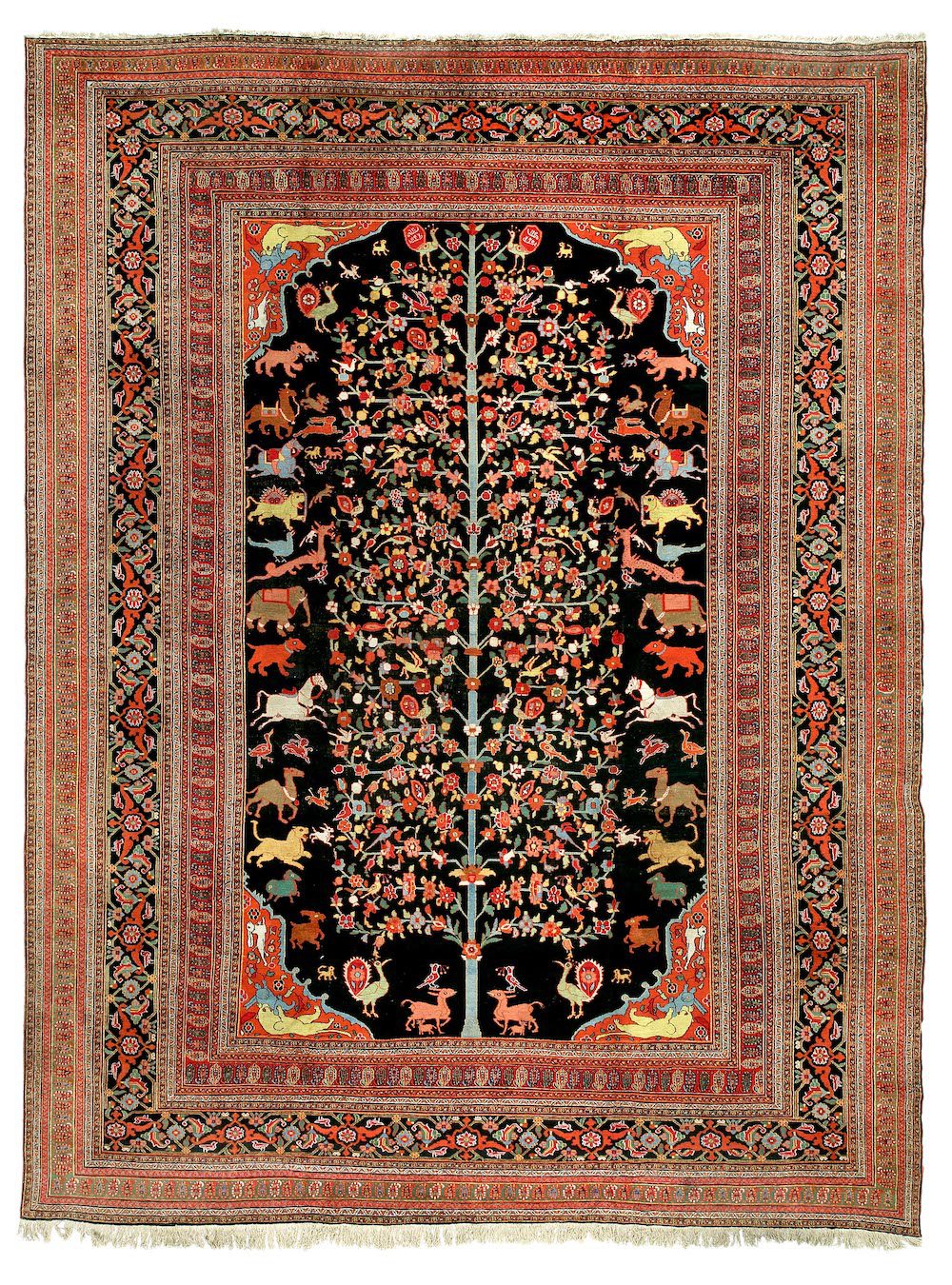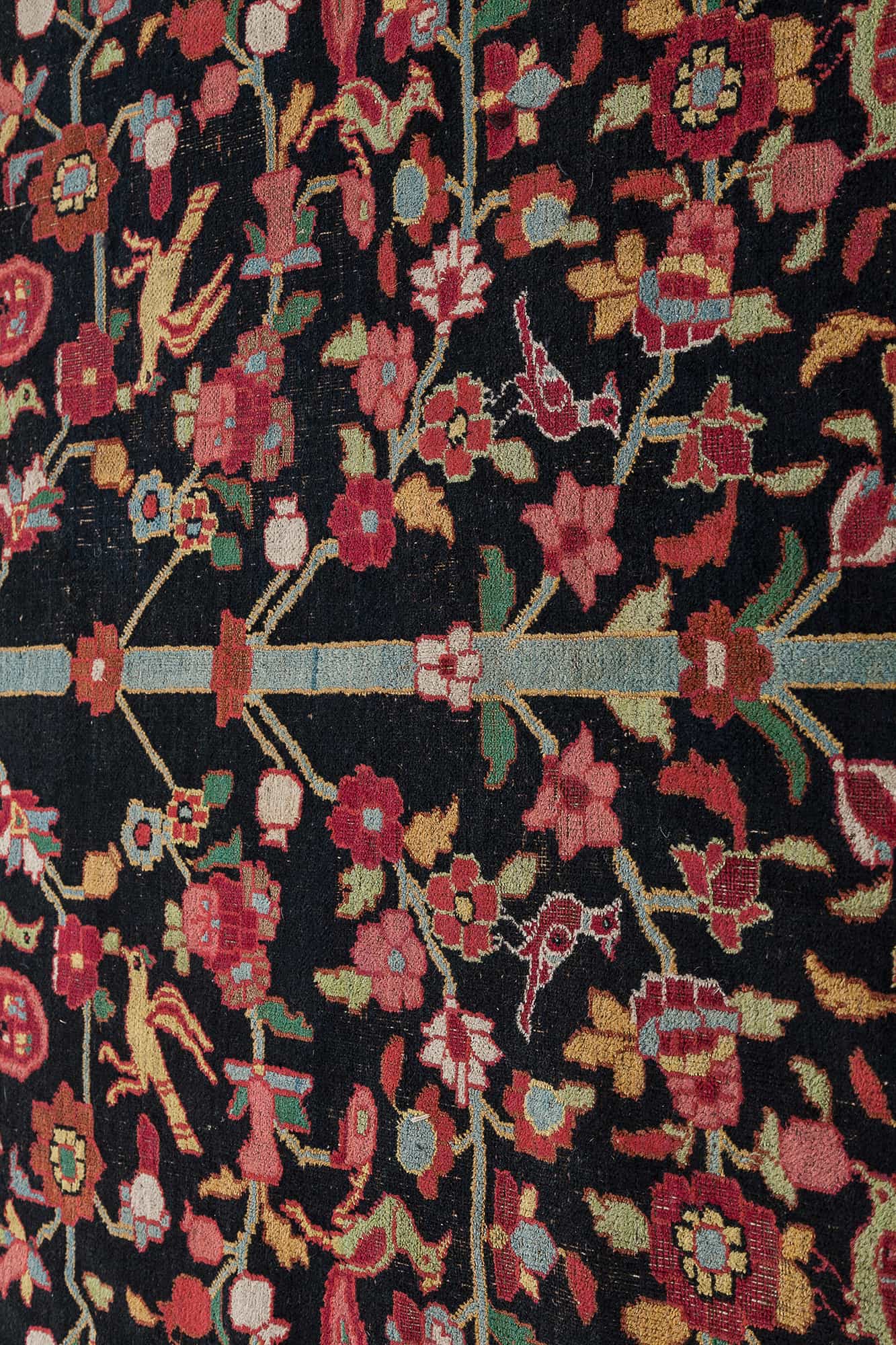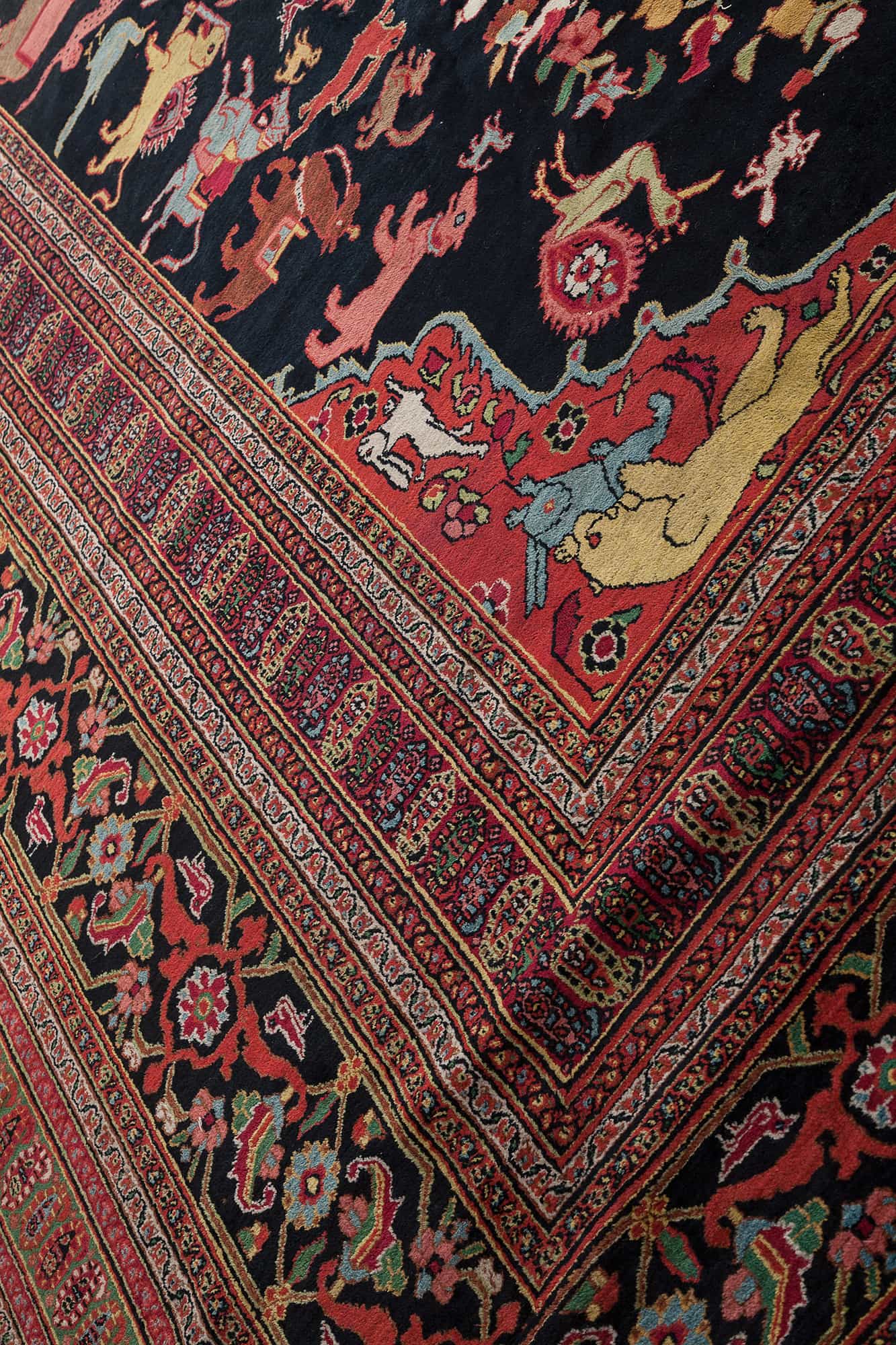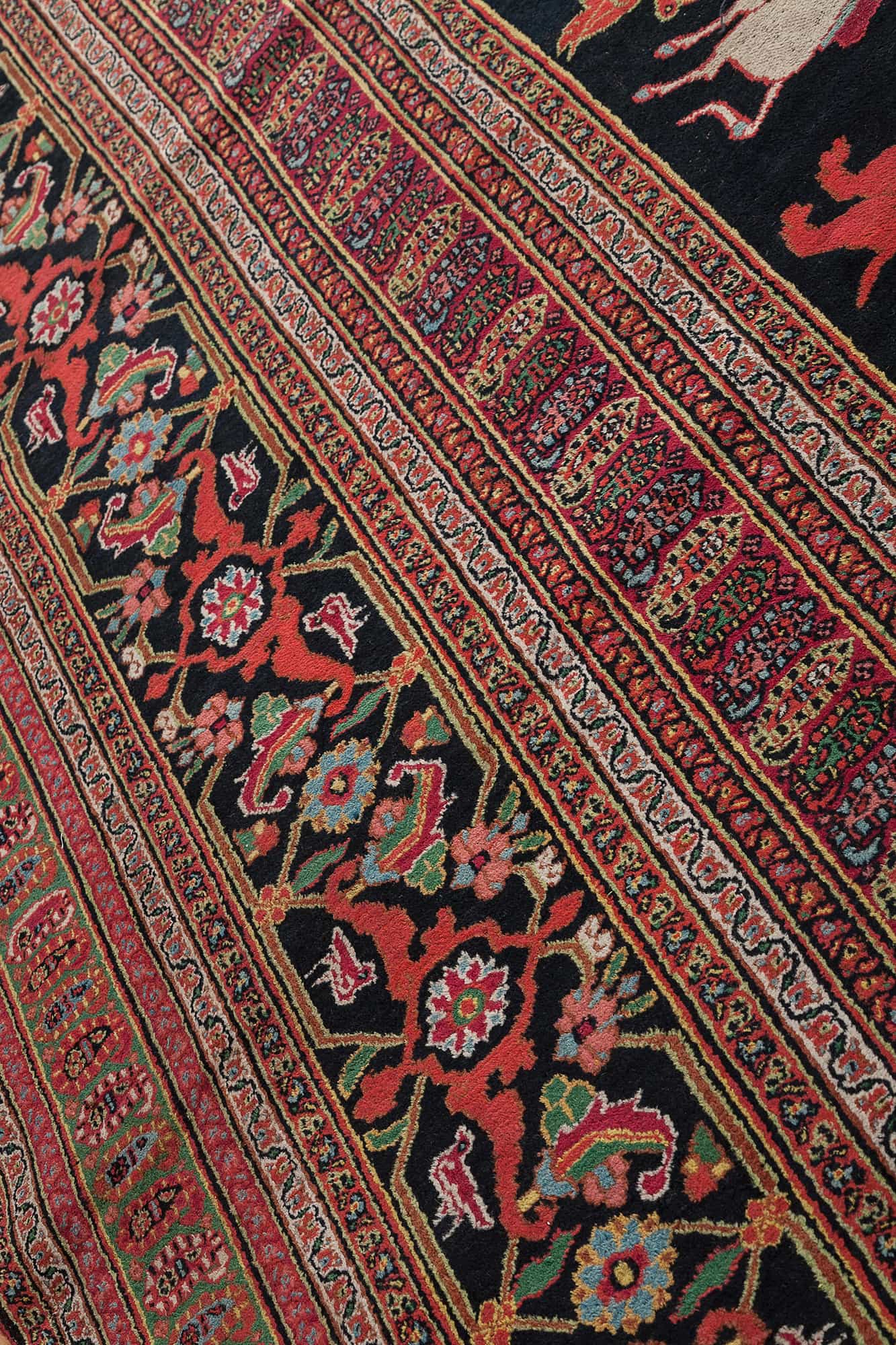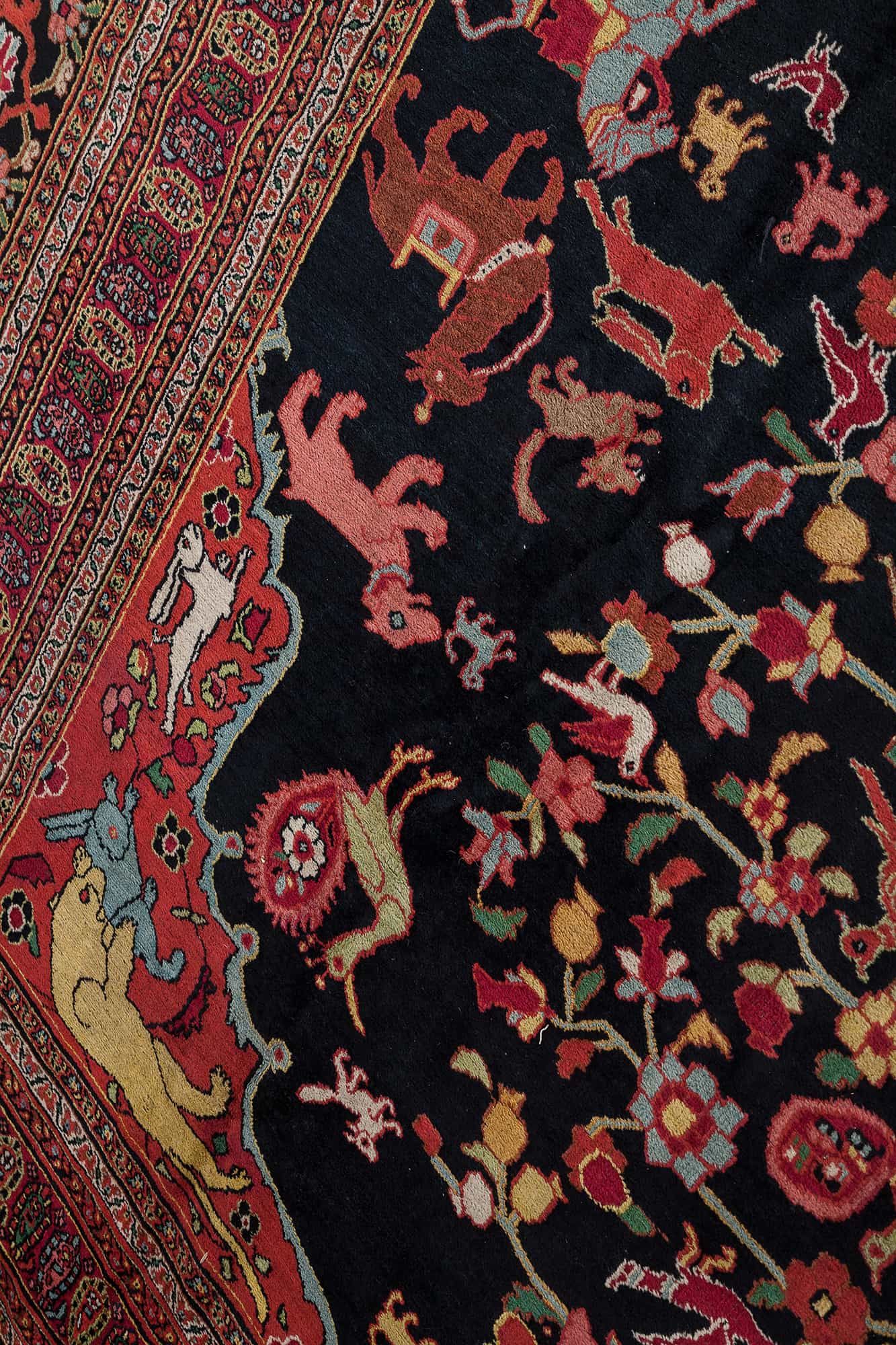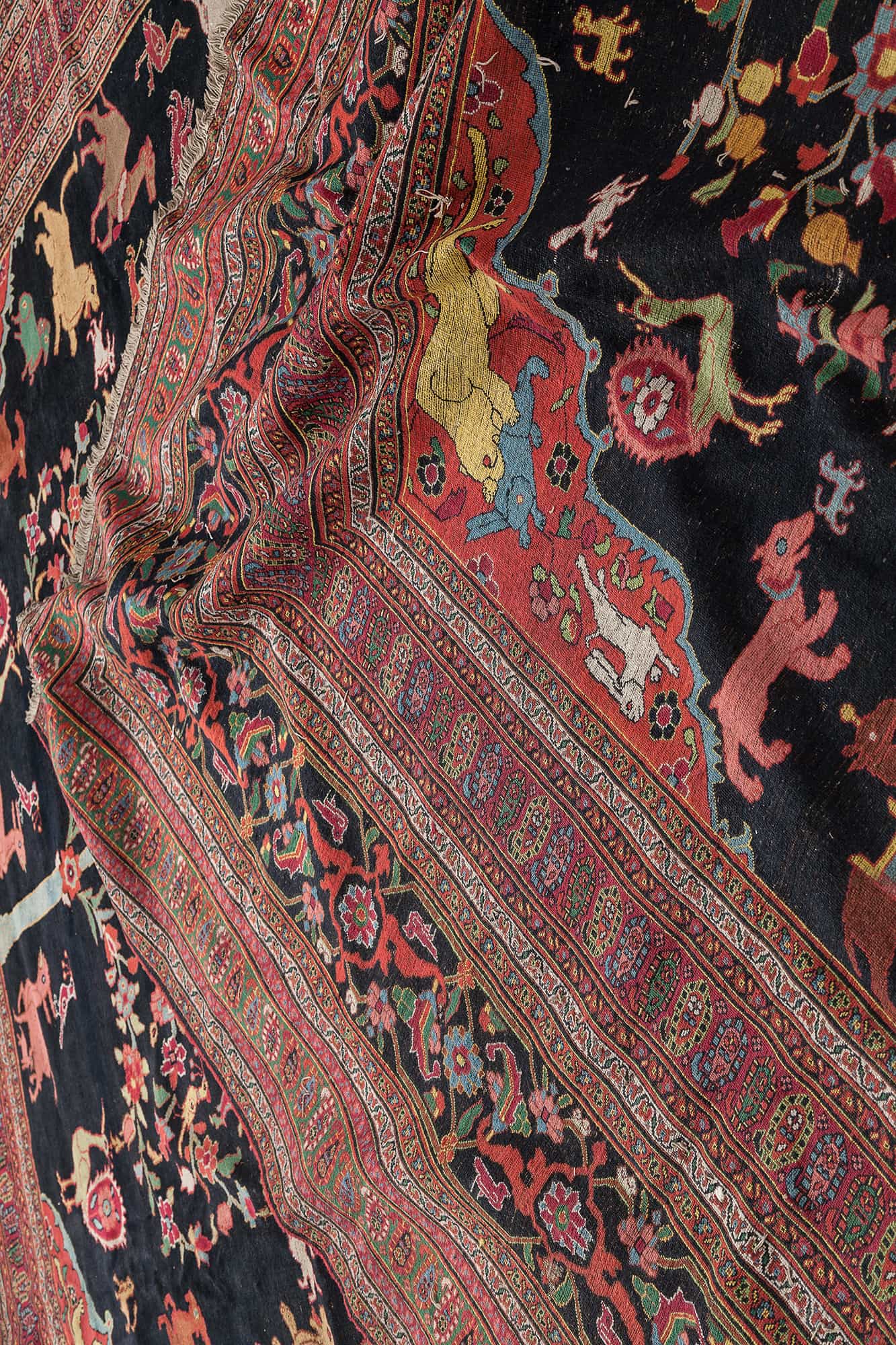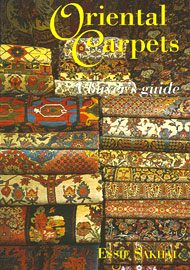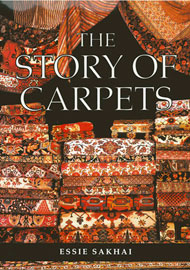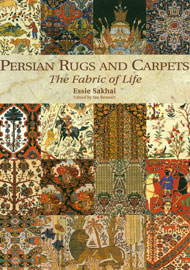Rare Dorokhsh ‘Tree of Life’ Carpet
Rug #2261Antique Dorokhsh Tree of Life Carpet Pictorial | Tree of Life Fine Kork Wool (Cashmere)
A Rare Dorokhsh Carpet, Khorasan, Northeast Persia, Wool on Cotton foundation,
Antique
The dark blue field with a central ascending tree issuing angular and curvilinear vines adorned with polychrome palmettes, flower heads and leaves, supporting small exotic birds, topped by a pair of peacocks bearing inscriptions, flanked by a variety of symbolic, wild, domestic and mythical animals, birds and ducks, within red spandrels adorned with combative animals, surrounded by a dark blue border enclosing continuous red turtle palmettes alternating with pale blue flower heads linked by angular vines issuing polychrome hooked leaves, supported by small birds, a red inner border enclosing continuous polychrome botehs, a similar green outer border supported by multiple guard borders
On first inspection due to the presence of an ascending tree into an arch, it could be assumed that this design presents a Prayer rug composition, however the asymmetry is in fact symmetrical due to the presence of corresponding mirrored spandrels at the bottom end. The jewel-like colours are typically from an extensive Dorokhsh palette of significant age, though the sheer number of varied colours present in this carpet is exceptional and are used to great artistic effect.
The field design would appear to represent a celebration of the natural world with a magnificent tree in full blossom displaying all its glory, and supported by a variety of traditionally represented animals and birds, natural, mythical, and symbolic. The symbolic element shows an historic emblem of Persia, for a full explanation see foot note. The drawing of the various fauna forms is unusual and rare to Dorokhsh, magnificently presented, consistent with a traditional style of drawing as seen in northwest Persian rugs, with a hint of naivety associated with a tribal style of drawing absent of naturalistic detail. The overall appearance is enhanced further by the presence of a dark background which brings to life the rich colours of the pattern details to superb dramatic decorative effect. The border arrangement is intriguing, firstly the main blue border displays continuous in and out ‘Turtle’ palmettes, so named as their shape resembles a turtle, though is purely a flora form which is a motif frequently seen in carpets throughout the rug making world drawn in varying styles dependant on regional traditions. The in and out arrangement gives a real sense of movement to the overall pattern, enhanced by the jewel like complementary colours. The minor border treatment is no less impressive, and is courageous in that normally such detailed borders would be present supporting a detailed field pattern, yet here supports a bold rendition. Multiple secondary borders or guard stripes are often seen in carpets from the Khorassan district and in this case the attention to detail particularly in the drawing of the boteh motif as seen continuously in the inner red and outer green guard borders is as important to any other pattern detail presented here, and enhances the overall visual impact. The elongated drawing of the boteh motif is characteristic to Dorokhsh weavers. The combination of both curvilinear and rectilinear drawing of the motifs is also worthy of note and is a relatively rare concept in the scheme of things.
This is a rare Persian Dorokhsh carpet, displaying an outstanding original design not just for Dorokhsh but conceptually for a woven work of art. Ultimately this Persian Dorokhsh carpet of rare large proportion presents a remarkable original and powerful image displaying a meaningful pictorial image open to interpretation.
Foot note:
The symbol most associated with Persia (Iran) is that of the Lion and the Sun. So much so that most observers forget that the originators of this symbol as an emblem of Persia, and subsequently, of its ruling house, were the Qajars (Kadjars), and subsequently adopted or rather continued by the Pahlavi dynasty. The symbol itself is of great antiquity. It has astrological reference to the constellation of Leo and its ascendancy when the sun is in Leo. It also refers to ancient symbols of royal lineages and divinity; the sun being a symbol of solar deities and, by extension, of solar lineages. Both the Sun and the Lion are also symbols of royalty from ancient times (e.g., “Lion of Judah”), the sun being the ruler of the heavens, and the lion being the ruler over the animals, as the king is the ruler over men. Closer in time to the Qajars (Kadjars), the emblem of the Lion and the Sun was used on banners of the Timurid dynasty of the Mughal rulers of India, notably those of Shah Jahan 1592-1666 (r.1627-1659), but also earlier by other Persian and Mughal rulers.
The emblem of the Lion and the Sun was first adopted officially by the Qajars (Kadjars) under Mohammad Shah (r.1834-48). The emblem changed over time from a lion (often depicted lying on the ground) and a sun with a human face, to a lion standing and holding a sword in its right paw and a sun across its back, to a lion standing and holding a sword in its right paw with a sun across its back and the Qajar (Kadjar) crown at the top of the sun, thus merging the double symbol of royalty and royal power with that of the Qajar (Kadjar) crown.
Antique Dorokhsh Tree of Life Carpet. This piece was handwoven in Dorokhsh, nearby to Mashad in the Khorasan province of Iran. For further information please contact us and our team will be pleased to assist you. All pieces in the collection are under the auspices of Essie Sakhai, one of the world’s foremost experts and collectors of fine handmade Persian rugs and carpets.

Delivery
Delivery
Enjoy Complimentary Express Delivery at Checkout
Free express next-day delivery on all UK orders.
Free express delivery on all international orders above £2,000.
Estimated Delivery Times
Please allow between 1-3 days for UK, Europe and United States destinations and 5-7 days for Far East, South America, Middle East destinations.
Please note that orders placed after 12pm (UK time), on the weekend, or during holidays will be processed on the following business day. You will be provided with a shipping tracking number once your order has been shipped.
Collection from our Mayfair London showrooms
In-store collection will be ready within 1 business day. To collect in-store you will be required to show confirmation e-mail, official photo ID (passport or driving license) and the payment card used for the order. If someone else is collecting on your behalf, please make sure they bring a letter of authorisation that permits this person to collect on your behalf, official photo ID of the purchaser and of the person collecting and confirmation e-mail.

Exchanges
Exchanges
Essie Carpets offers clients a lifetime exchange service on any items purchased from us should you wish to change your carpets at any time in the future, subject to the item being in good condition; this can be particularly useful when redecorating your home, or when an upgrade in type or quality is desired.

Payment
Payment
Payments are accepted via credit card or debit card with a valid billing and shipping address*. Accepted credit cards are Visa, American Express, and Mastercard. When placing an order, your billing address must correspond to the address of your credit card, or we will not be able to process your order.
Bank Transfers are also accepted; in order to pay by Bank Transfer, please contact our Client Services via telephone at +44 20 7493 7766 or e-mail at sales@essiecarpets.com.
All transactions are secured. The Essie Carpets website is provided with an SSL encryption system to protect personal and payment data.

